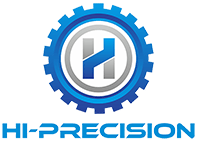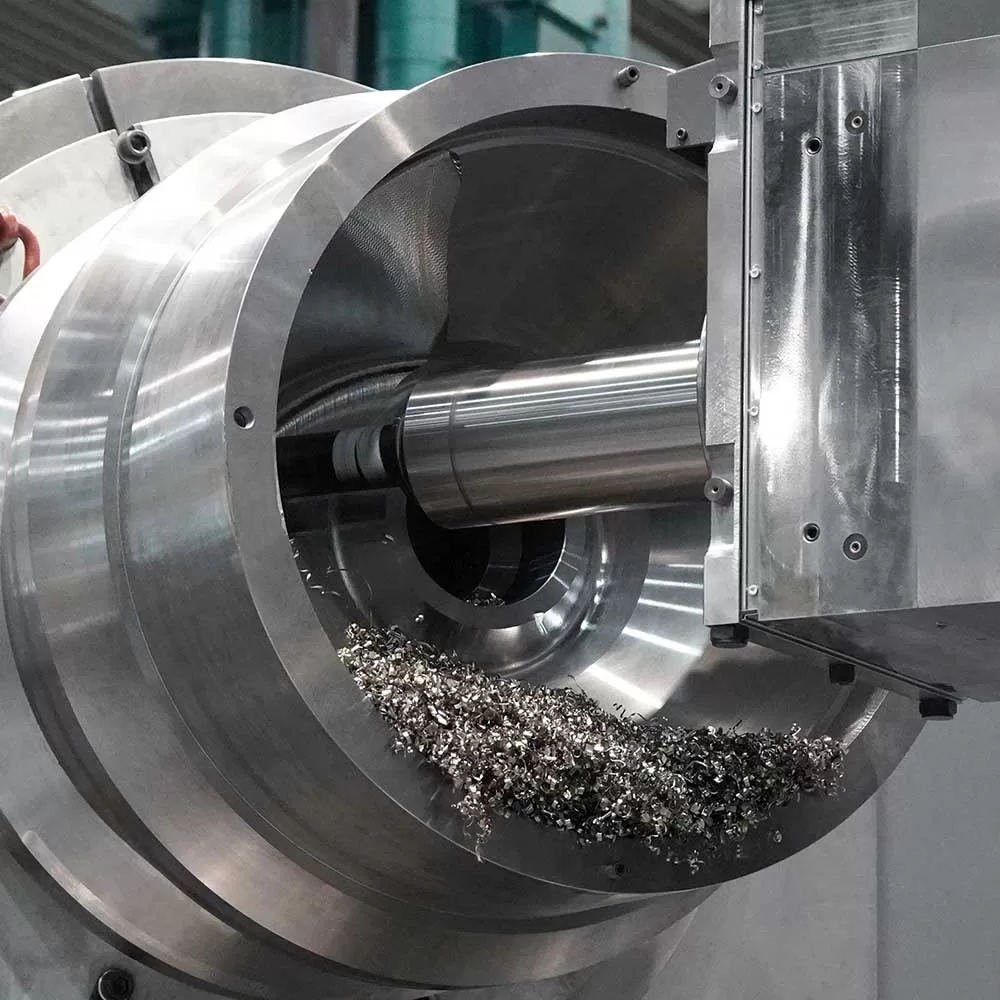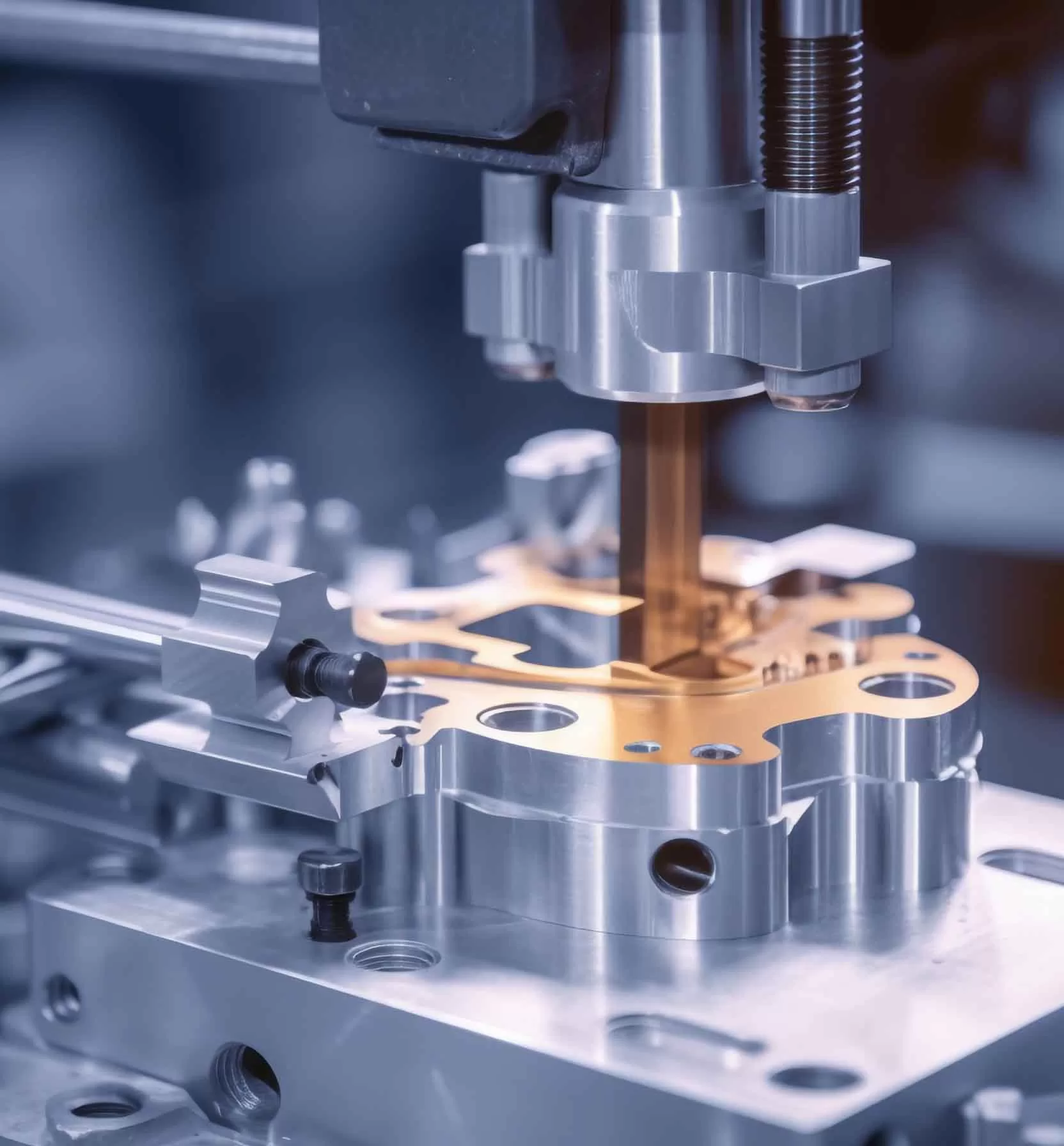Thermal deformation is one of the reasons that affects CNC machining accuracy. Machine tools are affected by changes in the ambient temperature of the workshop, motor heating and mechanical motion friction heat, cutting heat and cooling media, resulting in uneven temperature rise in various parts of the machine tool, resulting in changes in the shape accuracy and machining accuracy of the machine tool.
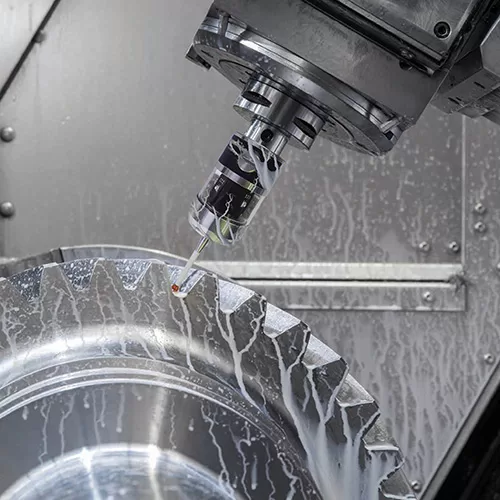
For example, when processing a 70mm × 1650mm screw on a CNC milling machine with ordinary CNC machining accuracy, compared with the workpiece milled between 7:30-9:00 am and the workpiece processed between 2:00-3:30 pm, the change in cumulative error can be up to 85m. Under constant temperature conditions, the error can be reduced to 40m.
For another example, a precision double-end face grinder used for double-end grinding of thin steel workpieces with a thickness of 0.6 to 3.5mm can achieve mm dimensional accuracy when processing 200mm×25mm×1.08mm steel workpieces, and the curvature is within Less than 5m in total length. However, after 1 hour of continuous automatic grinding, the size change range increased to 12m, and the coolant temperature increased from 17°C at startup to 45°C. Due to the influence of grinding heat, the spindle journal elongates and the spindle front bearing clearance increases. Based on this, a 5.5kW refrigeration machine was added to the machine tool coolant tank, and the effect was very ideal. Practice has proved that the deformation of machine tools after heating is an important reason that affects CNC machining accuracy. However, machine tools are in an environment where the temperature changes at any time and anywhere; the machine tool itself will inevitably consume energy when working, and a considerable part of this energy will be converted into heat in various ways, causing physical changes in the various components of the machine tool. This change is due to They vary greatly due to different structural forms, differences in materials and other reasons. Machine tool designers should understand the heat formation mechanism and temperature distribution rules, and take corresponding measures to minimize the impact of thermal deformation on CNC machining accuracy.
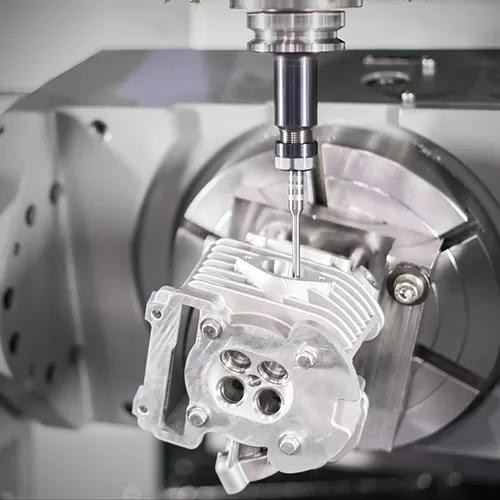
The temperature rise and temperature distribution of machine tools, as well as the influence of natural climate, my country has a vast territory, and most of the areas are in subtropical areas. The temperature changes greatly throughout the year, and the temperature difference changes within a day. As a result, people have different ways and degrees of intervention in indoor (such as workshops) temperature, and the temperature atmosphere around machine tools varies widely. For example, the seasonal temperature range in the Yangtze River Delta region is about 45°C, and the day and night temperature changes are about 5°C to 12°C. Machine shops generally have no heating in winter and no air conditioning in summer. However, as long as the workshop is well ventilated, the temperature gradient in the machine shop will not change much. In the Northeast, the seasonal temperature difference can reach 60°C, and the day and night variation is about 8 to 15°C. The heating period is from late October to early April of the following year. The machine shop is designed with heating and insufficient air circulation. The temperature difference between inside and outside the workshop can reach 50℃. Therefore, the temperature gradient in the workshop in winter is very complicated. The outdoor temperature was 1.5°C during the measurement, and the time was from 8:15 to 8:35 am. The temperature change in the workshop was about 3.5°C. The CNC machining accuracy of precision machine tools will be greatly affected by the ambient temperature in such a workshop.
Influence of the surrounding environment The surrounding environment of the machine tool refers to the thermal environment formed by various layouts within the close range of the machine tool.
They include the following 4 aspects:
- Workshop microclimate: such as the distribution of temperature in the workshop (vertical direction, horizontal direction). The room temperature will change slowly when day and night change or when climate and ventilation change.
- Workshop heat sources: such as solar radiation, radiation from heating equipment and high-power lighting lamps, etc. When they are close to the machine tool, they can directly affect the temperature rise of the whole or part of the machine tool for a long time. The heat generated by adjacent equipment during operation will affect the temperature rise of the machine tool in the form of radiation or air flow.
- Heat dissipation: The foundation has a good heat dissipation effect. Especially the foundation of precision machine tools should not be close to underground heating pipes. Once it breaks and leaks, it may become a heat source that is difficult to find the cause; an open workshop will be a good “radiator” , which is beneficial to the temperature balance in the workshop.
- Constant temperature: The use of constant temperature facilities in workshops is very effective in maintaining precision and processing CNC machining accuracy of precision machine tools, but it consumes a lot of energy.
Thermal influencing factors inside machine tools:
- Structural heat sources in machine tools. Motors that generate heat, such as spindle motors, feed servo motors, cooling and lubricating pump motors, electric control boxes, etc., can all generate heat. These situations are allowed for the motor itself, but they have a significant adverse impact on components such as the spindle and ball screw, and measures should be taken to isolate them. When the input electric energy drives the motor to run, except for a small part (about 20%) that is converted into motor heat energy, most of it will be converted into kinetic energy by the motion mechanism, such as spindle rotation, workbench movement, etc.; but inevitably there is still a considerable part It is converted into frictional heat during movement, such as bearings, guide rails, ball screws, transmission boxes and other mechanisms.
- Cutting heat in the process. During the cutting process, part of the kinetic energy of the tool or workpiece is consumed in cutting work, and a considerable part is converted into the deformation energy of the cutting and the friction heat between the chip and the tool, causing the tool, spindle and workpiece to heat up, and a large amount of chip heat is transferred to the workbench fixture of the machine tool. and other parts. They will directly affect the relative position between the tool and the workpiece.
- cool down. Cooling is a reverse measure against the increase in machine tool temperature, such as motor cooling, spindle component cooling, and basic structural component cooling. High-end machine tools are often equipped with a refrigerator for the electric control box to provide forced cooling.
The influence of the structural form of machine tools on temperature rise. In the field of thermal deformation of machine tools, the structural form of machine tools is discussed, which usually refers to issues such as structural form, mass distribution, material properties, and heat source distribution. The structural form affects the temperature distribution, heat conduction direction, thermal deformation direction and matching of the machine tool.
- The structure of the machine tool. In terms of overall structure, machine tools include vertical, horizontal, gantry and cantilever types, etc., and their thermal response and stability are quite different. For example, the temperature rise of the spindle box of a gear-speed lathe can be as high as 35°C, causing the spindle end to lift up, and the thermal equilibrium time takes about 2 hours. As for the inclined bed type precision turning and milling machining center, the machine tool has a stable base. The rigidity of the whole machine is significantly improved. The main shaft is driven by a servo motor, and the gear transmission part is removed. The temperature rise is generally less than 15°C.
- Effect of heat source distribution. In machine tools, the heat source is usually considered to be the motor. Such as spindle motor, feed motor and hydraulic system, etc., are actually incomplete. The heat generated by the motor is only the energy consumed by the current in the armature impedance when it is under load, and a considerable part of the energy is consumed by the heat caused by the friction work of bearings, screw nuts, guide rails and other mechanisms. Therefore, the motor can be called a primary heat source, and the bearings, nuts, guide rails and chips are called secondary heat sources. Thermal deformation is the result of the combined influence of all these heat sources. Temperature rise and deformation of a column-mobile vertical machining center during Y-direction feed movement. The worktable does not move when feeding in the Y direction, so it has little effect on thermal deformation in the X direction. On the column, the farther away from the Y-axis guide screw, the smaller the temperature rise. The situation when the machine is moving in the Z-axis further illustrates the influence of heat source distribution on thermal deformation. The Z-axis feed is further away from the X direction, so the impact of thermal deformation is smaller. The closer the column is to the Z-axis motor nut, the greater the temperature rise and deformation.
- Effect of mass distribution. The influence of mass distribution on thermal deformation of machine tools has three aspects. First, it refers to the size and concentration of mass, which usually refers to changing the heat capacity and heat transfer speed, and changing the time to reach thermal equilibrium.
By changing the arrangement of the mass, such as the arrangement of various ribs, the thermal stiffness of the structure is improved, and the influence of thermal deformation is reduced or the relative deformation is kept small under the same temperature rise;
It refers to reducing the temperature rise of machine tool components by changing the form of mass arrangement, such as arranging heat dissipation ribs outside the structure.
Influence of material properties: Different materials have different thermal performance parameters (specific heat, thermal conductivity and linear expansion coefficient). Under the influence of the same heat, their temperature rise and deformation are different. Testing of thermal performance of machine tools.
The purpose of thermal performance testing of machine tools. The key to controlling thermal deformation of machine tools is to fully understand the changes in ambient temperature of the machine tool, the heat source and temperature changes of the machine tool itself, and the response (deformation displacement) of key points through thermal characteristic testing. Test data or curves describe the thermal characteristics of a machine tool so that countermeasures can be taken to control thermal deformation and improve the CNC machining accuracy and efficiency of the machine tool.
Specifically, the following purposes should be achieved:
- Test the surrounding environment of the machine tool. Measure the temperature environment in the workshop, its spatial temperature gradient, changes in temperature distribution during the alternation of day and night, and even the impact of seasonal changes on the temperature distribution around the machine tool.
- Thermal characteristics testing of the machine tool itself. Under the condition of eliminating environmental interference as much as possible, the machine tool is placed in various operating states to measure the temperature changes and displacement changes of important points of the machine tool itself, and record the temperature changes and key point displacements within a long enough period of time, and also An infrared thermal camera can be used to record the heat distribution in each time period.
- The temperature rise and thermal deformation of the machining process are tested to determine the impact of the thermal deformation of the machine tool on the CNC machining accuracy.
- The above-mentioned tests can accumulate a large amount of data and curves, which will provide reliable criteria for machine tool design and users to control thermal deformation, and point out the direction of taking effective measures.
Principle of thermal deformation test of machine tools The thermal deformation test first needs to measure the temperature of several relevant points, including the following aspects:
- Heat source: including each part of the feed motor, spindle motor, ball screw transmission pair, guide rails, and spindle bearings.
- Auxiliary devices: including hydraulic system, refrigerator, cooling and lubrication displacement detection system.
- Mechanical structure: including bed, base, slide plate, column, milling head box and spindle. An indium steel measuring rod is clamped between the spindle and the rotary table, and five contact sensors are configured in the X, Y, and Z directions to measure the comprehensive deformation under various states to simulate the relative displacement between the tool and the workpiece. .
- Test data processing and analysis The thermal deformation test of machine tools should be carried out over a long continuous period of time, with continuous data recording. After analysis and processing, the reflected thermal deformation characteristics are highly reliable. If errors are eliminated through multiple trials, the regularity shown is credible. A total of 5 measurement points were set up in the thermal deformation test of the spindle system, among which points 1 and 2 are at the end of the spindle and near the spindle bearing, and points 4 and 5 are respectively at the milling head housing near the Z-direction rail. The test lasted for a total of 14 hours, of which the spindle speed varied alternately in the range of 0 to 9000r/min for the first 10h. Starting from the 10th hour, the spindle continued to rotate at a high speed of 9000r/min.
The following conclusions can be drawn:
- The thermal equilibrium time of the spindle is about 1 hour, and the temperature rise change range after equilibrium is 1.5°C;
- The temperature rise mainly comes from the spindle bearing and spindle motor. Within the normal speed range, the thermal performance of the bearing is good;
- Thermal deformation has little effect in the X direction;
- The Z-direction telescopic deformation is large, about 10m, which is caused by the thermal elongation of the main shaft and the increase in bearing clearance;
- When the rotational speed continues to be 9000r/min, the temperature rises sharply, rising sharply by about 7℃ within 2.5 hours, and has a continuing upward trend. The deformation in the Y and Z directions has reached 29m and 37m, indicating that the spindle is operating at a rotational speed of 9000r /min can no longer run stably, but it can run in a short time (20min). The control of thermal deformation of machine tools is analyzed and discussed above. The temperature rise and thermal deformation of machine tools have various factors that affect CNC machining accuracy. When taking control measures, we should grasp the main contradictions and focus on one or two measures to achieve twice the result with half the effort. . In the design, we should start from four directions: reducing heat generation, reducing temperature rise, structural balance, and reasonable cooling.
Reducing heat generation and controlling heat sources are fundamental measures. In the design, measures should be taken to effectively reduce the calorific value of the heat source.
Reasonably select the rated power of the motor. The output power P of the motor is equal to the product of the voltage V and the current I. Under normal circumstances, the voltage V is constant. Therefore, an increase in the load means that the output power of the motor increases, that is, the corresponding current I also increases, then the current The heat dissipated in the armature impedance increases. If the motor we design and select works for a long time close to or greatly exceeds the rated power, the temperature rise of the motor will increase significantly. To this end, a comparative test was conducted on the milling head of the BK50 CNC needle groove milling machine (motor speed: 960r/min; ambient temperature: 12°C). From the above experiments, the following concepts are obtained: From the perspective of heat source performance, whether it is a spindle motor or a feed motor, when selecting the rated power, it is best to choose a power that is about 25% larger than the calculated power. In actual operation, the output power of the motor is consistent with the load. Matching, increasing the rated power of the motor has little impact on energy consumption. But it can effectively reduce the temperature rise of the motor.
